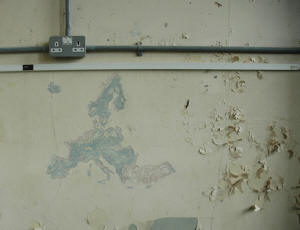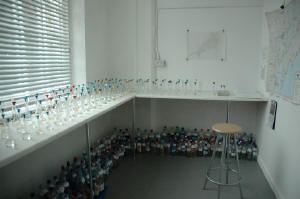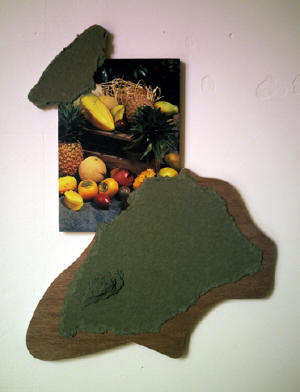| artcornwall | |||
| home | features | exhibitions | profiles | gazetteer | links | archive | forum | |||
A response to eek
19th August to 14th October 2006
The Old Grammar School, Redruth
“…we still dream of liberty as we dreamed of it when we were children. What other psychological freedom do we have than the freedom to dream? Psychologically speaking, it is in reverie that we are free beings.”[1] Gaston Bachelard
Jacqueline Knight’s camera moves
around the abandoned school, focusing on battered coffee-cream coloured
walls, shabby paintwork, a lone plastic chair. Strip lights hang from
rusty chains and drill holes gape where furniture has been ripped out. The
route taken by her lens obeys my first reaction to being back in a
schoolroom, which is to seek out the nearest exit. As if in response,
light creeps across an open doorway and blazes though a window pane. Motes
of dust catch the sun in a drunken dance then the blackboard is abruptly
reanimated by an eruption of chalk marks. Reminiscent of Svankmajer’s A
Quiet Night in the House, shapes morph and are erased as soon
as they appear. I am transported back to algebra lessons and the pressure
of absorbing esoteric knowledge against the clock. Paced to magnify this
anxiety, the images accumulate to a frenzied swarm of mathematical symbols
before the camera retreats through the darkening school like a long, slow
exhalation. Knight’s work forms a triangle of enchantment with that of Andy Currie and Dale Berning beside it, particularly as sound from Berning and Knight travels between the non-insulated spaces of the three. Berning agitates my sense of orientation with noises thrown into the transitional area that was the school cloakroom. Marbles speeding across a parquet floor, wind chimes, plucked elastic and random scrapes and bumps build a confusion of sound that speaks of playtime, unregulated open-ended actions. Her large drawings are like a visual interpretation of the sounds. An eclectic collection of objects overlaps into a quiet white expanse. Non-compartmentalised and non-discriminating, yet with an internal harmonious logic, these drawings are also a little like the mind of a child. Andy Currie (above) kicks
playfully against pedagogical constraints with his kinetic models, linked
together in the science lab like some chain experiment. He has stabilized
wobbly desks with a pack of cards and a Danielle Steel novel, sneaky
interlopers in the classroom. Remember those crowd-pleasing science
experiments that stick in everybody’s mind, the sodium fizzing in water,
the Van de Graaff generator? Curry uses dusty fans to blow shreds of black
bin bags and polystyrene balls, creating the death throes of a scorpion
and a comical co-dependent dance between bag and ball. Moving through the snowy peaks of Sovay Berriman’s installation, Pass I stumble across Stacey Righton’s Scattered Maps. These are paint peelings arranged on the floor into the shapes of countries. Righton has scraped directly into the wall at knee height, excavating her own precise atlas, down to the subtly coloured hues of the underlying stonework. Rather than sanitizing the space as a backdrop for the work, she has selectively retained pieces of graffiti and used the fabric of decay itself to explore symbolic representations of knowledge. She also draws attention to the inherent patterns in dilapidation, the cracks and torn paintwork we gazed at during lost hours of dreaming in the classroom. Jane Atkinson’s Trace Elements is the end stage in a body of research that revolved around the collection, collation and mapping of data. In a pristine laboratory water samples crowd the floor and sit in neatly regimented lines on the desks. The walls are papered with maps and charts illustrating the location and density of different metalliferous compounds in rivers throughout Cornwall. Her collaboration with environmental scientists forced Atkinson to weigh the visual and technical aspects of her research with an emphasis upon interpretation and outcome: …“catching a moment in time” she asks, “…is that not what contemporary art practice is all about?”
Like much of the work here the
most vivid connections are made in our imagination, Mike Cooter’s film Dead Reckoning is a B-movie re-make where a man visits the city morgue to discover the truth about the death of a friend. The spoken word is abstracted by the use of sign language and subtitles so that the exaggerated posturing of the actors takes on a much greater significance. We see neither the grotesquely burned corpse nor the circumstances of his death, but we recognise the narrative form and fill the gaps in between. Barry Thompson mixes the sentimental intensity of nineteenth century romanticism with adolescent yearnings. His meticulous drawings of birds and rock stars like To My Bird (Part V) and Bleach placed above song lyrics and poetry could be pages torn from a private diary. They contrast with Sovay Berriman’s blousy poster wall pieces, Forage, Bounty and Harvest. The cheap construction (hardboard and underlay) and the technicolour waxy sheen of these images takes me back to the 1970s schoolroom like no other part of the show.
Megan Wakefield October 2006 [1] Bachelard, Gaston in The Poetics of Reverie: Childhood, Language and the Cosmos (Beacon Press: Boston) 1969
|
|||
_small.jpg)


